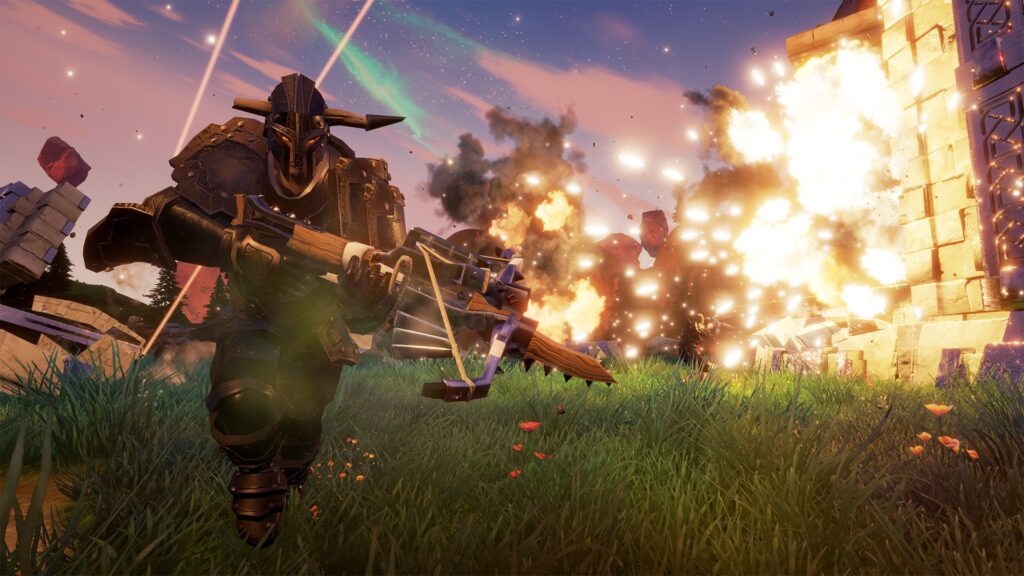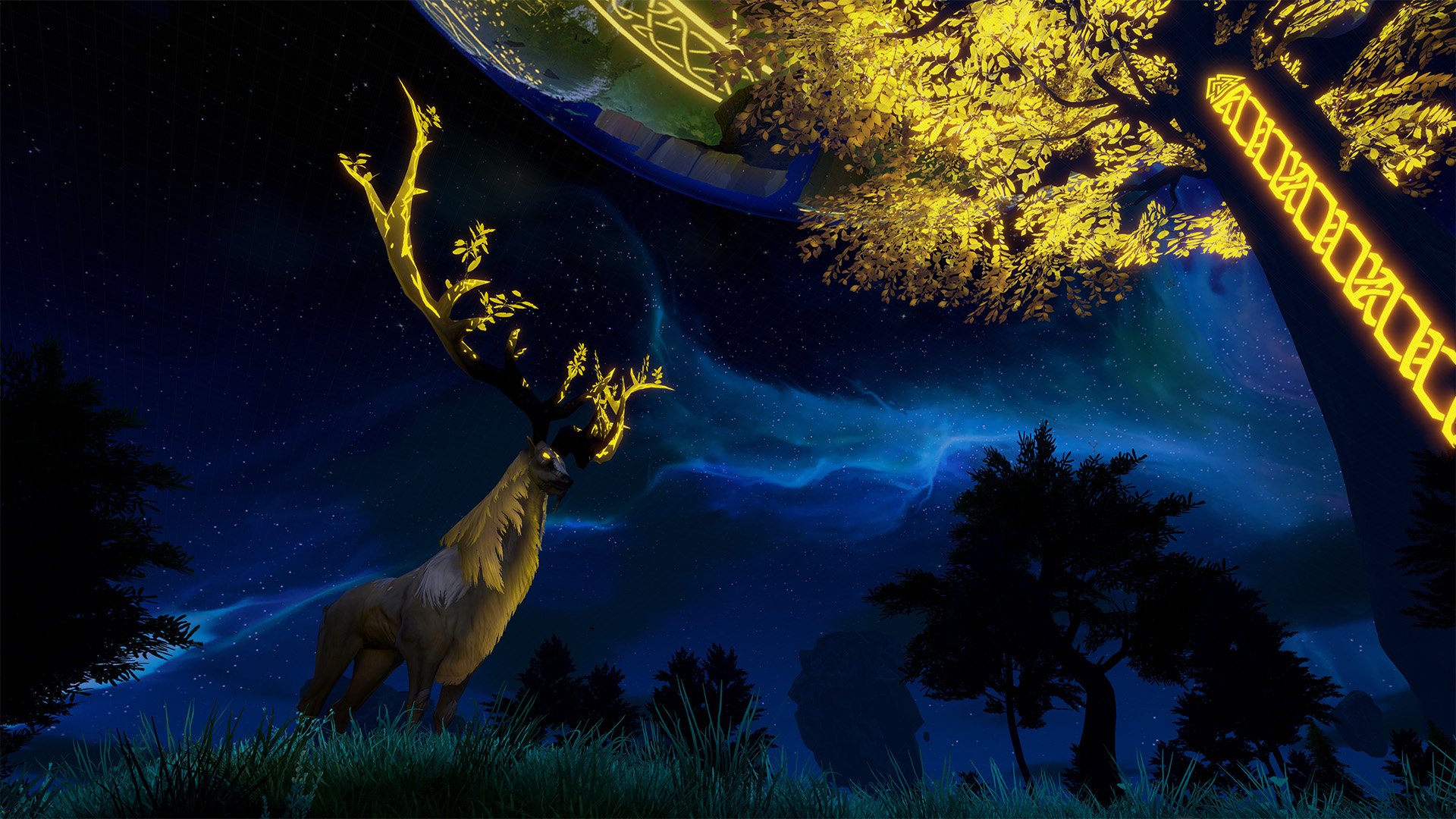
Game developers today live in a brave, new world. Although how studios ultimately develop their titles is a choice, many opt for an open development process that brings players along for the ride even at the earliest stages. That openness stemmed from the wave of Kickstarter pitches along with Valve’s introduction of Steam Early Access about five years ago, but it brings a number of pros and cons to the table.
Soliciting feedback from players can be incredibly valuable for developers as they continue to tweak and iterate on their designs. But when they open themselves up to a community, warts and all, they’re making themselves vulnerable.This is especially true in an online environment that is too often saddled with toxicity. In some ways, this must be an even greater challenge for veterans of the industry for whom this open atmosphere never existed. And yet, the team at Frostkeep, comprised of Blizzard veterans who have over 75 collective years making games like World of Warcraft and Overwatch, have launched survival title Rend into Early Access and they’re embracing this open methodology.
Jeremy Wood, co-founder and CEO, explained to GameDaily that diving into Early Access has given his team the ability to make exactly the kind of game his audience wants.

“What we tried to do is actually just be very flexible with our vision, our game design. The game that we ended up releasing in Early Access is not the game we started making two years ago,” he noted. “We’ve made massive swings in direction based on feedback we were getting from our pre-alpha players and checking out to see what the industry is trending towards, what people are hungry for. That’s something that we feel like we can keep doing during Early Access because the game says ‘Early Access.’ It’s meant to change a lot, whereas if we released it in a full finished state, it would be a little more set in stone and we’d be less free to react to where players want the game to go.”
There’s no bigger trend in gaming right now than battle royale, as evidenced by the monumental success of Fortnite and PUBG. Those games didn’t exist when Frostkeep started work on Rend, but Wood did refer to 2016 battle royale title H1Z1: King of the Kill as one of the games that got his team thinking.
“One of the big ones that happened was H1Z1: King of the Kill… That went crazy when we were starting and then of course PUBG followed and Fortnite. I mean we’re definitely not making a battle royale [title], but there’s elements of that which are interesting. We can see what [players] just really are latching on to, and see if we can kind of fill the same psychological needs that are being filled by those games in ours. Who knows where it’s going to go from here,” he said.
If you just talk to us, you’ll find that we’re absolutely listening to feedback. We’re truly creating a space where our player base is part of the development team. I think that really makes the attitudes just more positive across the board.
As we’ve seen with the ArenaNet debacle, where two writers were fired over their social media interactions with players, how or even if developers interact with their audience has become a complicated situation. If you’re not prepared to fully engage and respond to your audience, there’s no point in trying to leverage Early Access. Wood has seen first-hand how the old guard of the games business had handled it, and a lot of developers are not prepared for the consistent communication that’s required in an open development process.
“It’s a double-edged sword. There’s a lot of danger and a lot of power in putting ourselves out there as a studio, as a product, and even as individuals,” he remarked. “We do expose ourselves to all sorts of nastiness, but that’s the internet. That’s the world we live in. I think we all do that everyday. It’s obviously a little different when you put yourself out there and paint a target on yourself. We don’t force any of our developers to do that. We encourage them all to do it and we definitely support them in their learning process along the way as they learn to become more public facing figures.
“It’s not something the industry does a great job of preparing people for in general, especially where, in the places we’ve been … At Blizzard you’re basically told, ‘Hey, don’t tell anybody in a game you work for Blizzard. We’ll have to delete your character or move it somewhere. If you ever talk to somebody you can say these two tiny things and other than that, refer them to PR.’ That’s basically the end of everyone’s training.”
Communications veteran Michele Cagle, who used to work at Daybreak and now handles PR for Frostkeep, emphasized that the community is now used to constant interaction with the development team. It’s no longer a surprise to the players when Wood joins a chat on Discord.
“That’s why we have people like Michele here to help us,” Wood continued. “We’ve trained everybody in how to handle talking to media, talking to people at events, just talking to random players that we find through our Discord channel or forums or whatever. Everyone has some basic idea of what the expectations are from our end and from the other end as well. I think the biggest thing that we take advantage of is honesty, which sounds cheesy and strange, but being actually open with people means that for the most part, when people are interacting with us, we don’t get a lot of the personal toxicity.
“We get people who are passionate and occasionally vitriolic, but when we say, ‘Hey, yeah. You know what? That feedback is totally legitimate. That’s something we’re going to address. Here’s some things we’ve already looked at here’s why we didn’t do those because they caused these other problems, but your perspective is clearly valid and here’s what we’re going to continue to look at.’
There’s no magic bullet to the toxicity problem in online communities, but like with any other relationship, you’d be surprised how far listening to another person can take you. People want to be heard, they want to know that you care about what they’re thinking.
Wood added, “If you have a candid discussion at that level, it turns around most people’s vitriol into, ‘Oh, okay. I’m being listened to. I’m used to [acting out to get attention.]’ People are used to having to go over the top and be nasty and crazy in order to get enough attention for a dev to listen to them. In our case, you don’t have to. If you just talk to us, you’ll find that we’re absolutely listening to feedback. We’re truly creating a space where our player base is part of the development team. I think that really makes the attitudes just more positive across the board.”
We never question whether it is a problem, because if people think it’s a problem, it’s a problem. We have to solve perception just as much as we have to solve actual mechanical issues.
One aspect of Early Access development that can be confusing from the outside looking in is how developers decide to incorporate all the feedback they receive. After all, players don’t usually have backgrounds in either game design or development. And while a studio can’t turn every single piece of feedback into an actionable item, there’s no such thing as bad feedback.
“In our opinion, all feedback is valid,” Wood insisted. “Some feedback comes packaged with fan solutions and … Sometimes there [are] great ideas there, but you have to drill down to what problem are they actually seeing, not how are they trying to solve it. If you do that, you’ll find value in every piece of feedback.
“Now that the volume has gone way up, it’s something we’re trying to sort through … but we are gathering it all and everyday the guys turn around their chairs and they’re like, ‘Okay, people are running into this.’ We kind of bubble up the top four or five issues for the day. We never question whether it is a problem, because if people think it’s a problem, it’s a problem. We have to solve perception just as much as we have to solve actual mechanical issues.”
Early Access affords developers the opportunity to mold a game based on player input, but the question of how long to leverage the program hasn’t been fully answered. Some titles have stayed in the program for years. At a certain point, you just have to rip the band-aid off.
“I don’t know how it’s going to shake out, but our goal is somewhere in the six- to nine-month range,” Wood stated. “We think that’s going to be enough time to really, completely solidify all the fungible aspects of the game. It will also help us shore up things that you expect from a full release game like having plenty of customer support and all that kind of stuff… just the overall polish not just of the game, but with all the trappings around the game. That’s something we’re working towards every single day. We’re actively working towards solidifying everything and taking that early access tag off.”
Frostkeep has shown a penchant for customer satisfaction and not just in how they handle Early Access. Online game subscriptions are a dying breed, but free-to-play means implementing microtransactions. Given the atmosphere surrounding microtransactions and loot boxes over the last year, it’s no surprise that some developers are staying clear. For Rend, Frostkeep has chosen the old-school monetization of pay once and just play, similar to Guild Wars.
“Those are all perfectly valid business models,” Wood said of subscriptions and microtransactions. “As a player, I don’t mind them. I know some people do, but some people also like the fact that those games are often free-to-play and so they have that low barrier to entry. I don’t think there’s a right or wrong answer. We just picked what we felt was best for our product and our studio.
“The big thing that we decided was, if we went with microtransactions where we could sell hairstyles or new fancy clothes or things like that … We could totally do that and it would probably make sense. But we didn’t want, as a development team, to be split between let’s spend time making money by making all these new microtransaction entries versus let’s spend time making the game [better]. I didn’t want to have to balance that. I didn’t want to feel like I have to choose between business and product. We all felt that the easiest way for us to really just focus on the game was to make it a very simple buy once policy… All we got to worry about is making the game the best we can make it.”
Rend will be highly streamable from the outset, too. It’s another way that Frostkeep is both watching the market and listening to their community. Matches are absolutely massive and with a 20 v 20 v 20 structure, they can even last weeks. But Frostkeep is aware that streamers need interesting content and some are trying to make a living with their streams, so the studio has given the streaming world a nod by scheduling in events, especially exciting when one of those includes times where shields come down around factions in the game.
“Early in our careers [streaming] didn’t really exist, so we’re having to adjust to what the new world is,” Wood acknowledged. “These content creators are basically your most important outlet for getting the word out about your game and so you need to make it as easy and fun for them as possible and then they become your evangelists. So we had them in mind from day one. We’re working with hundreds of them at this point, just helping them get what they need from a game structure perspective, so that they can deliver the best content they can to their viewers because that’s ultimately what they’re interested in. So it’s been on the forefront of our minds since the beginning for sure.”
With Frostkeep’s Blizzard pedigree, expectations for Rend are understandably high. Blizzard’s games have always been polished to a level that most studios can’t match. And while polish is a great lesson to take from years of working at Blizzard, it’s not the crux of what Frostkeep’s founders learned.

“Our biggest takeaway from our Blizzard experience is you can make a fantastically unique product without really inventing anything new,” Wood explained. “Blizzard got where they are by taking inspiration from all sorts of different great pieces of games in different genres … And maybe [some] games weren’t successful, but I mean you can find a nugget of greatness in any game and Blizzard was very successful at hunting those things down.
“That’s how you get something new and unique without having to take a big risk in creating brand-new mechanics that nobody’s ever seen before. That’s always tricky. That’s how we approached Rend. We said, ‘Hey. The survivor genre has lots of issues, but it also has lots of people flocking to it and let’s figure out what that is. Why are people drawn to this gameplay?’ And we found that the really visceral nature of starting with absolutely nothing and building up your entire kingdom from your bare hands every step of the way was an experience that really only the survival genre was delivering. So, okay, let’s take that and then what are some of the problems with survival?”
Our development style is very flat. It’s very collaborative and it works great with the 17 people we have now. If we try to make this a 40-man dev team, I’m not sure that our development style would work… We have to grow enough to be able to support the game, but not so much that we’d have to change who we are.
He continued, “Well, you have to ready your base at 4:00 in the morning. Having to compete with you and your one buddy against 20 other guys. When we started looking at how do other games solve these things … and we saw a lot of interesting stuff from the MMO space with the Dark Age of Camelot, even PlanetSide where you put these three factions together and you have pre-built social structures that way, and then you pit them against each other in this long-form style battle. That seemed to fit really well with the survival side as well, so we stuck that in there.
“Then we borrowed all sorts of inspiration from other RPGs, MMOs for just, how do you progress your character. That’s one of the things we always love playing MMOs is having multiple avenues for character progression. Having it so every character ends up being very different from every other character and that was something that we hadn’t seen in survival.”
The “Blizzard thinking” may be ingrained in Wood’s head, but he certainly doesn’t want Frostkeep to grow like Blizzard. Aside from the huge overhead of a big studio, there are advantages to staying relatively small.
“Our development style is very flat. It’s very collaborative and it works great with the 17 people we have now,” Wood described. “If we try to make this a 40-man dev team, I’m not sure that our development style would work. We have to be very cognizant of that. We have to grow enough to be able to support the game, but not so much that we’d have to change who we are.
“When I started Blizzard, there were 179 people in the whole company, including Blizzard North. By the time I left, it was 4,000 something. I mean it was a great company when I started, it was a great company when I left, but it wasn’t the same company. There’s definitely just a transition that had to happen as you move across certain thresholds. A lot of companies aren’t going to survive that. At least not with their personalities intact. We definitely pride ourselves on being different as developers and we’re not going to jeopardize that with any sort of rapid growth.”
 GameDaily.biz © 2025 | All Rights Reserved.
GameDaily.biz © 2025 | All Rights Reserved.